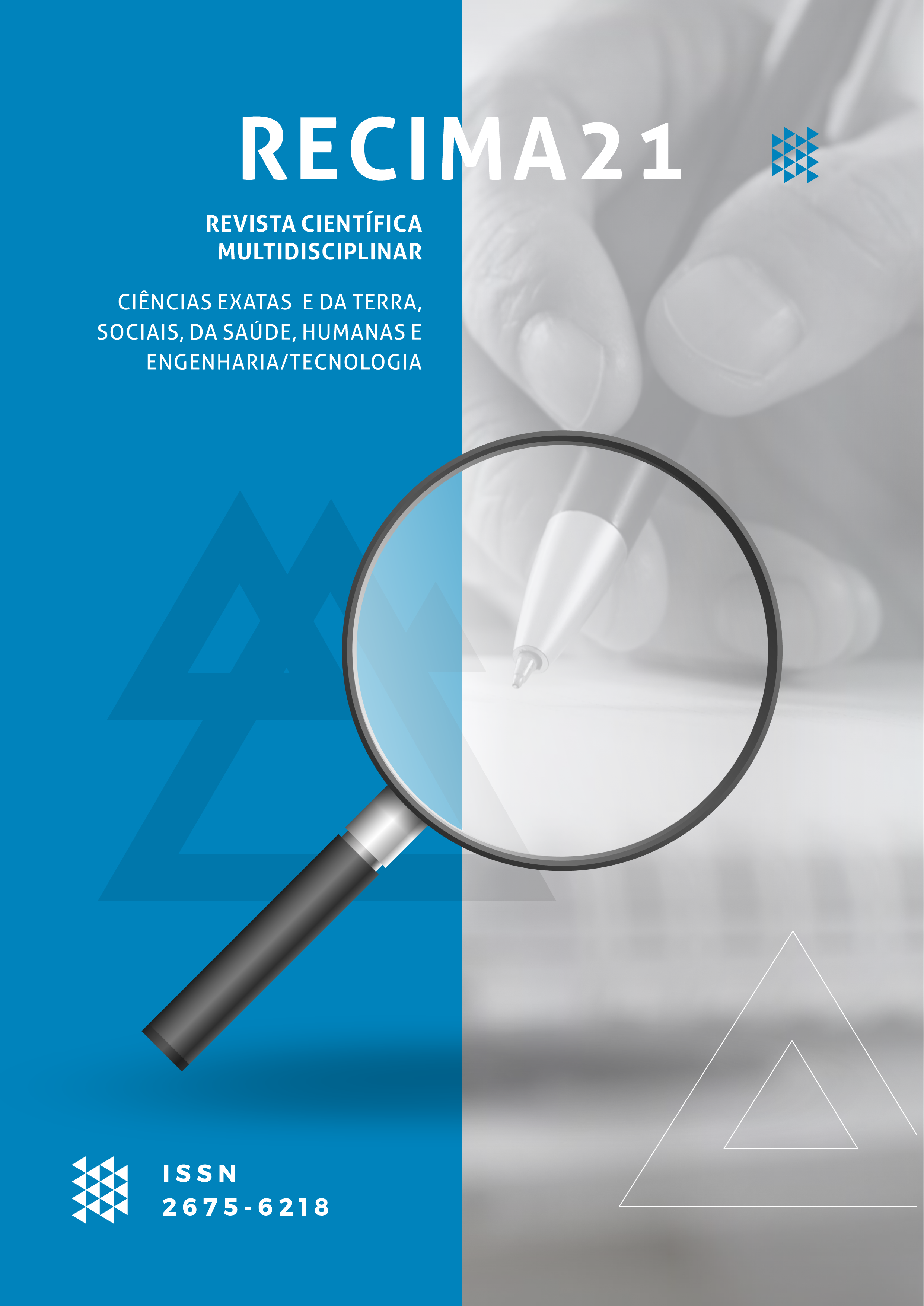EFICÁCIA DAS INTERVENÇÕES NA PREVENÇÃO DA HIPOTERMIA DO PREMATURO: REVISÃO INTEGRATIVA DA LITERATURA
DOI:
https://doi.org/10.47820/recima21.v3i7.1707Palavras-chave:
Hipotermia, Recém-nascido prematura, Pacotes de assistência ao pacienteResumo
Considera-se hipotermia a temperatura axilar menor que 36,5ᵒC. A hipotermia moderada é diretamente responsável por injúrias ao neonato, principalmente a Hemorragia Peri-intraventricular e a severa aumenta a chance de óbito neonatal, hipoglicemia, acidose metabólica, apneia e contribui para o aumento nas taxas de morbimortalidade. Objetivou-se analisar as intervenções utilizadas na prevenção da hipotermia em recém-nascidos prematuros, sua eficácia e efetividade. Foram pesquisados através dos bancos de dados MEDLINE, PubMed e Web of Science artigos científicos publicados nos últimos cinco anos que abordassem o impacto na implantação de intervenções para diminuição da hipotermia em prematuros. Foram encontrados 14 artigos que incluíram a intervenção preventiva para hipotermia ao prematuro. O tamanho das amostras variou de 59 a 9.833 pacientes e a idade gestacional dos prematuros entre 24 e 36 semanas. Foram observadas diversas intervenções sendo o uso de saco plástico de polietileno a intervenção mais aplicada para diminuir a perda de calor por evaporação. Conclui-se que os estudos evidenciaram a diminuição significativa da hipotermia na admissão do recém-nascido na unidade de tratamento intensivo após adotar uso de pelo menos uma das estratégias de prevenção da hipotermia no prematuro. Além de mostrar que a hipotermia é prevalente em prematuro de baixo peso, existindo associação entre hipotermia na admissão e outras morbidades.
Downloads
Referências
Brasil, Ministério da Saúde, Atenção à Saúde do Recém-Nascido: guia para os Profissionais de Saúde. 2ª ed. v. 1, Brasília, 2014.
Mccall E., Alderdice F, Halliday H, Johnston L, Vohra S. Challenges of Minimizing Heat Loss at Birth: A Narrative Overview of Evidence-Based Thermal Care Interventions. Newborn and Infant Nursing Reviews. 2014; 14(2): 56–63.
Fanaroff AA, Martin RJ. Diseases of the fetus and infant. Chapter 30: Physical environment. 9th ed., p. 567-568, 2011.
Gomella TL. Chapter 06: thermal regulation. Neonatology: management, procedures, on-call problems, diseases, and drugs. 7a ed., Lange, 2013, p. 65 – 70.
Von. Database of very low birth weigth infants. Report of infants 501 to 1500 grams born in 2012, generated on August 14, 2013. Burlingon, VT: Von-Vermont Oxford Network, 2013. Acessado em 10/04/2016.
Pereira R, Figueiroa MNC, Barreto IC, Naiara L, Marcelle CC, Lemos LC, Marques VLR. Perfil Epidemiológico Sobre Mortalidade Neonatal e Evitabilidade. Rev. Enfem. UFPE on line. 2016; 10(5): 1763-72.
El Dib R. Guia prático de Medicina Baseada em Evidências [recurso eletrônico]/organização. – 1. ed., São Paulo: Cultura Acadêmica, 2014. Acessado em 20/07/2016.
Ursi ES, Prevenção de lesões de pele no perioperatório: revisão integrativa da literatura. 2005. 130f. Dissertação. Escola de Enfermagem. Universidade de São Paulo, 2005.
Jia YS, Lin ZL, Lv H, Li YM, Green R, Lin J. Effect of delivery room temperature on the admission temperature of premature infants: a randomized controlled trial. Journal of Perinatology. 2013; 33: 264-267.
Vohra S, Reilly M, Rac VE, Bhaloo Z, Zayack D, Wimmer J, et al. study protocol for multicentre brandomized controlled trial of HeLP (Heat Loss Prevention) in the delivery room. Contemp Clin Trials. 2013; 36(1):54-60.
Rohana J, Khairina W, Boo Y, SHAREENA I. Reducing hypothermia in preterm infants with polyethylene wrap. Pediatr Int. 2011; 53(4):468-74.
Çağlar S, Gözen D, İnce Z. Heath Loss Prevention (Help) After Birth in Preterm Infants Using Vinyl Isolation Bag or Polyethylene Wrap. J Obstet Gynecol Neonatal Nurs. Mar-Apr 2014; 43(2): 216-23. doi: 10.1111/1552-6909.12291.
Pinheiro JMB, FURDON SA, BOYNTON S, DUGAN R, REU-DONLON C, JENSEN S. Decreasing Hypothermia During Delivery Room Stabilization of Preterm of neonates. Pediatrics. 2014; 133(1): 218-26.
Russo A, Mccready M, Torres L, Theuriere C, Venturini S, Spaight M, et al. Reducing Hypothermia in preterm Infants Following Delivery. Pediatrics. 2014;133:e1055–e1062.
Doglione N, Cavallin F, Mardegan V, Palatron S, Filippone M, Vecchiato L, et al. Total Body Polyethylene Wraps for Prevention Hypothermia in preterm Infants: A Randomized Trial. The Journal of Pediatrics. 2014; 165: 261-6.
Leadford AE, Warren JB, Manasyan A, Chomba E, Salas AA, Schelonka R. Plastic bags for prevention of hypothermia in preterm and low birth weight infants. Pediatrics. 2013;132(1): 128-34.
Godfrey K, Nativio DG, Bender CV, Schlenk EA. Occlusive bags to prevent hypothermia in premature infants: a quality improvement initiative. Adv Neonatal Care. 2013; 13(5):311-6.
Manani M, Jegatheesan P, Desandre G, Song D, Showalter L, Govindaswani B. Elimination of Admission Hypothermia in Preterm Very Low-Birth-Weight Infants by Standardization of Delivery Room Management. The Permanente Journal. 2013; 17(3): 8-13.
Billimoria Z, Chawla S, Bajaj M, Natarajan G. Improving admission temperature in extremely low birth weight infants: a hospital-based multi-intervention quality improvement project. J. Perinat. 2013; 41: 455-460.
Miller SS, Lee HC, Gould JB. Hypothermia in very low birth weight infants: distribution, risc factores and outcomes. J Perinatol. 2011;31 Suppl 1:S49-56.
Lyu Y, Shah PS, Ye XY, Warre R, Piedboeuf B, Deshpandey A, et al. Association Between Admission Temperature and Mortality and Major Morbidity in Preterm Infants Born at Fewer Than 33 Weeks’ Gestation. JAMA Pediatr. 2015;169(4): e150277.
Almeida MFB, Guinsburg R, Sancho GS, Rosa IRM, Lamy ZC, Martinez FE, et al. Hipothermia and Early Neonatal Mortality in Preterm Infants. J. Pediatr. 2014;164(2): 271-5.e1.
Brachine JDP, Peterlini MAS, Pedreira MLG. Método Bundle na redução de infecção de corrente sanguínea relacionada a cateteres centrais: revisão integrativa. Rev Gaúcha Enferm. 2012; 33(4): 200-210.
Silva SG, Nascimento ERP, Salles RK. Bundle de prevenção da pneumonia associada à ventilação mecânica: uma construção coletiva. Texto Contexto Enferm. Florianópolis, 2012; 21(4): 837-44.
Downloads
Publicado
Edição
Seção
Categorias
Licença
Copyright (c) 2022 RECIMA21 - Revista Científica Multidisciplinar - ISSN 2675-6218

Este trabalho está licenciado sob uma licença Creative Commons Attribution 4.0 International License.
Os direitos autorais dos artigos/resenhas/TCCs publicados pertecem à revista RECIMA21, e seguem o padrão Creative Commons (CC BY 4.0), permitindo a cópia ou reprodução, desde que cite a fonte e respeite os direitos dos autores e contenham menção aos mesmos nos créditos. Toda e qualquer obra publicada na revista, seu conteúdo é de responsabilidade dos autores, cabendo a RECIMA21 apenas ser o veículo de divulgação, seguindo os padrões nacionais e internacionais de publicação.













